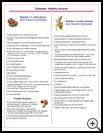
Diabetes: Healthy Snacks
________________________________________________________________________
KEY POINTS
- Snacks can help to prevent low blood glucose.
- The best choices for snacks are foods that are high in protein, high in fiber, and low in saturated fat.
- It helps to work with a dietitian to help make good food choices.
________________________________________________________________________
Is it OK to include snacks in my child’s diabetic meal plan?
The need for snacks depends on your child’s blood glucose control and how many calories your child needs to eat per day. Active children and teens with high energy needs usually need to add snacks.
Snacks can help to prevent low blood glucose. You may want to include snacks in your child’s meal plan because:
- Snacks can help balance the food your child eats with the medicines your child takes.
- Eating smaller meals and having snacks with protein may help your child avoid hunger and overeating.
- Your child needs to spread the carbohydrates that he eats more evenly throughout the day to help decrease spikes in blood glucose after meals.
- Your child exercises and wants to prevent a drop in his blood glucose.
Which foods are good snacks?
Different types of snacks have different effects. The best choices for snacks are foods:
- Low in saturated fat, such as lean meats, or low or fat-free milk products
- High in fiber, such as fruits, vegetables, nuts, or whole grain foods
Snacks that are high in protein and fiber may satisfy hunger longer. Sugar from fruit will last 1 or 2 hours, so fruit is good for a morning or afternoon snack. Carbohydrates (carbs) eaten with proteins, such as low-fat cheese or lean meat, change to sugar more slowly.
Bedtime snacks are important for blood glucose control for children with diabetes who use insulin. A snack that includes carbohydrate and protein helps to keep up your child's blood glucose level through the night. A typical bedtime snack should include 15 grams of carbohydrate and 7 to 8 grams of protein. This amount can change based on your child's age, blood glucose levels, and activity throughout the day.
Milk and yogurt are a natural mix of carbohydrate and protein and make a good bedtime snack choice.
If your child is still hungry after a snack, try low calorie foods like a vegetable tray using cold crunchy vegetables and a fat-free dressing for a dip.
Help your child avoid mindless snacking while watching TV, driving, reading, or working at the computer.
For more information, contact
- The American Diabetes Association
800-342-2383
http://www.diabetes.org
Last modified: 2018-01-10
Last reviewed: 2018-01-10

